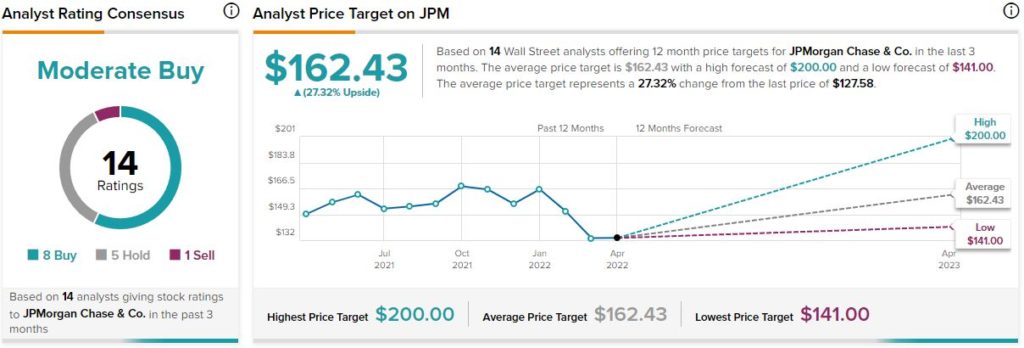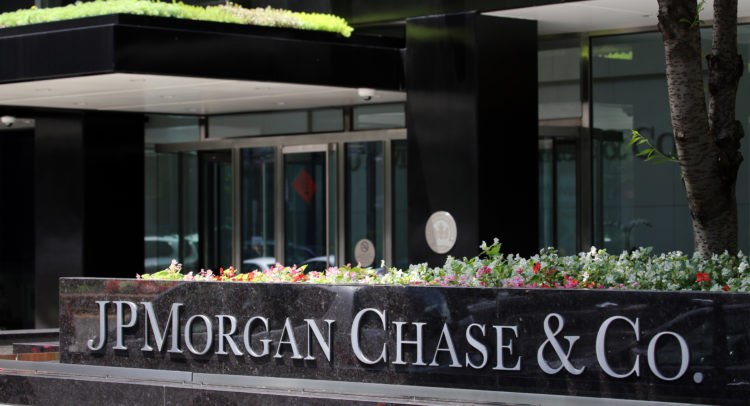JPMorgan Chase & Co. (JPM) is one of the most prominent financial institutions in the U.S., boasting more than $3.0 trillion in assets under management.
The company’s international operations comprise Consumer & Community Banking, Commercial Banking, Corporate & Investment Banking, and Asset & Wealth Management. JPMorgan is also by far the largest diversified bank in the U.S. by market cap. The company is valued at around $370 billion, with Bank of America (BAC), the second-largest diversified bank, worth around $313 billion.
JPMorgan’s investment case is distinguished from that of its peers due to its numerous competitive advantages. These include the bank’s massive scale, diversified cash flows, and world-class reputation. I have historically seen JPMorgan as a quality investment, as it features growth, rich qualities, and vigorous capital returns.
Following the stock’s correction year-to-date, JPMorgan shares have become rather attractive. While its Q1 results appeared weaker compared to last year amid the excessive release of net credit reserves at the time, the bank’s bottom-line prospects for the year remain rock solid.
Further, management’s new capital return program should positively impact the bank’s per-share earnings, which, combined with the possibility for a valuation expansion, make JPMorgan’s investment thesis rather tempting.
I remain bullish on JPMorgan.
Declining Earnings are Not Worrisome
For the first quarter of Fiscal 2022, JPMorgan reported revenues of $30.7 billion, a 5% decline year-over-year. Additionally, net income came in at $8.3 billion, declining by a much more substantial 42% during this period. However, this quarter’s results need some context.
Specifically, last year’s earnings of all banks were boosted dramatically by reserve releases, resulting in net income levels almost doubling year-over-year at the time.
Most bank balance sheets strengthened in 2021 due to the release of COVID-era credit loss allowances, which include the reserves financial institutions amassed since the pandemic started to absorb the possible scenario of some borrowers being incapable of meeting their debt obligations.
In Q1, JPMorgan reported a net credit reserve build of $902 million compared to a net credit reserve release of $5.2 billion in the comparable period last year. Thus, the massive net income decline is only synthetic and should not spur unnecessary worries.
Overall, Q1 results were rather mixed. On the one hand, in Consumer & Community Banking, deposits grew 18% while client investment assets rose 9%, primarily boosted by positive net flows.
Combined debit and credit card spending also increased 21% as JPMorgan continues to see a revival in credit card spending, specifically when it comes to travel and dining.
On the other hand, card loan balances grew 11% but were still below pre-COVID levels. While auto loans also grew by 3%, the scarcity of vehicle supply kept limiting originations, which declined by 25%.
Clearly, the current economic environment has grown market uncertainty on multiple fronts. The goal of JPMorgan this year should be to minimize the damage of the current global turmoil to the company and its clients alike instead of maximizing profitability like last year.
However, investors need to recognize that Fiscal 2022 should still be a rather profitable year for the company considering the overall circumstances. Wall Street analysts expect the company to deliver EPS of $11.18 for the year, implying a decline of around 26.9% versus Fiscal 2021 due to the aforementioned reasons.
Still, this implies a robust 25.7% growth compared to Fiscal 2020, which illustrates the positive earnings growth trajectory excluding last year’s reserve release.
Huge Buybacks to Boost Per-Share Metrics
Assuming the current drivers of global economic uncertainty start fading from Fiscal 2023, JPMorgan’s earnings growth should resume from next year. However, the company’s massive buybacks alone should have an accretive effect on its per-share metrics.
The company has a long history of large buyback programs. Last year, JPMorgan repurchased around $18.4 billion worth of its common stock. In its most recent quarter, buybacks amounted to $1.7 billion, while the board has now authorized a new share repurchase program of $30 billion, effective May 1st, 2022.
This equals about 8% of JPMorgan’s current market capitalization, which should suggest that the company will be retiring a significant amount of its common stock in the short-to-medium term.
Wall Street’s Take
Turning to Wall Street, JPMorgan has a Moderate Buy consensus rating based on nine Buys, seven Holds, and one Sell assigned in the past three months. At $162.43, the average JPMorgan price target implies 27.3% upside potential.

Takeaway
JPMorgan shares have declined substantially from their 52-week lows amid elevated uncertainty following the ongoing global turmoil. While the sell-off has not been entirely unjustifiable, it appears to me that shares could be rather attractively priced at their current levels.
Despite what looks like a substantial earnings drop in its most recent results, a drop is only natural following last year’s reserve release. Despite that, JPMorgan should still end the year with notably higher profits than its pre-COVID levels.
Combined with the new repurchase program, which should significantly boost investors’ total capital return yield along with the current 3.17% dividend yield, JPMorgan offers value with a relatively wide margin of safety.
Discover new investment ideas with data you can trust.
Read full Disclaimer & Disclosure









